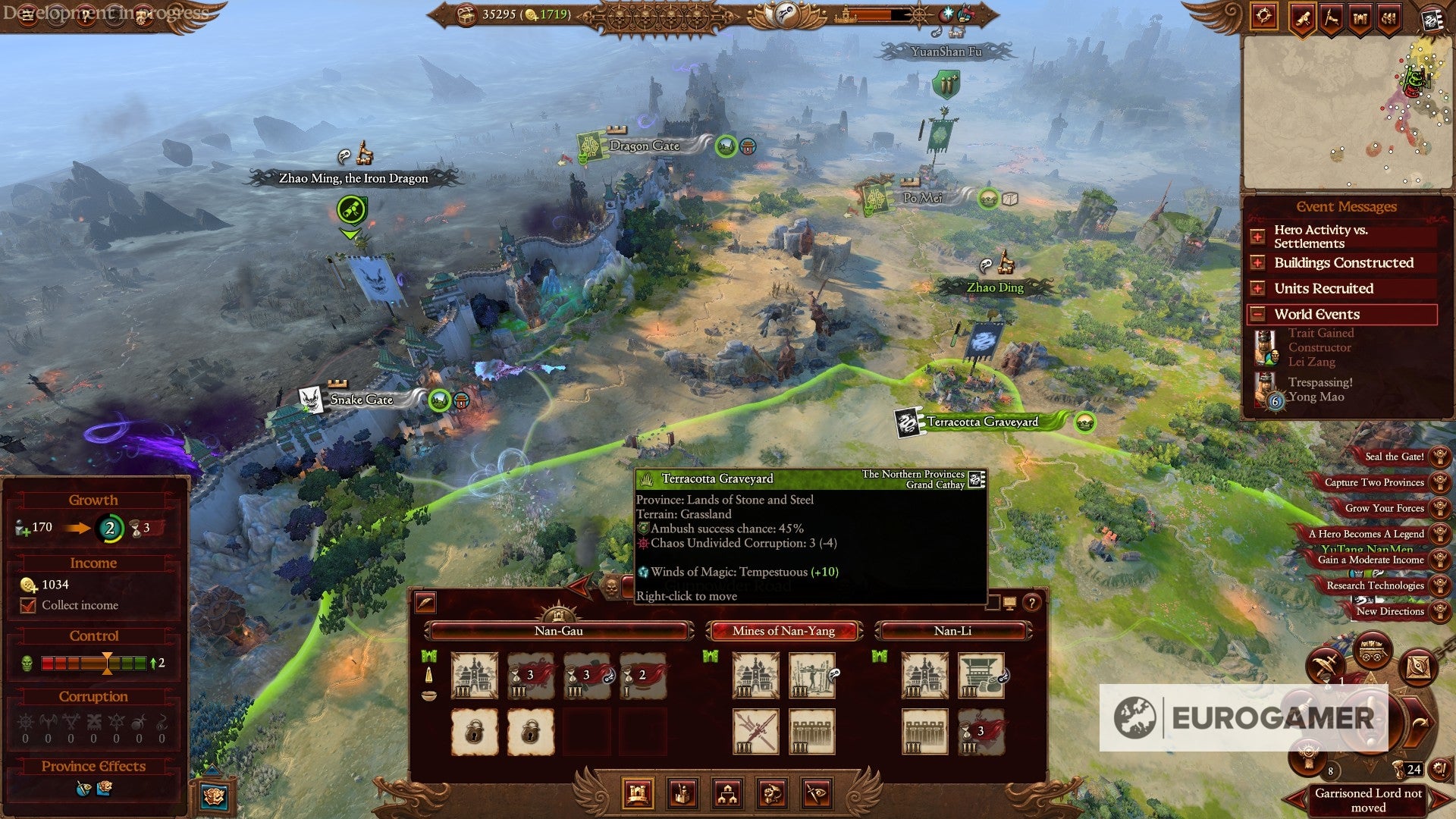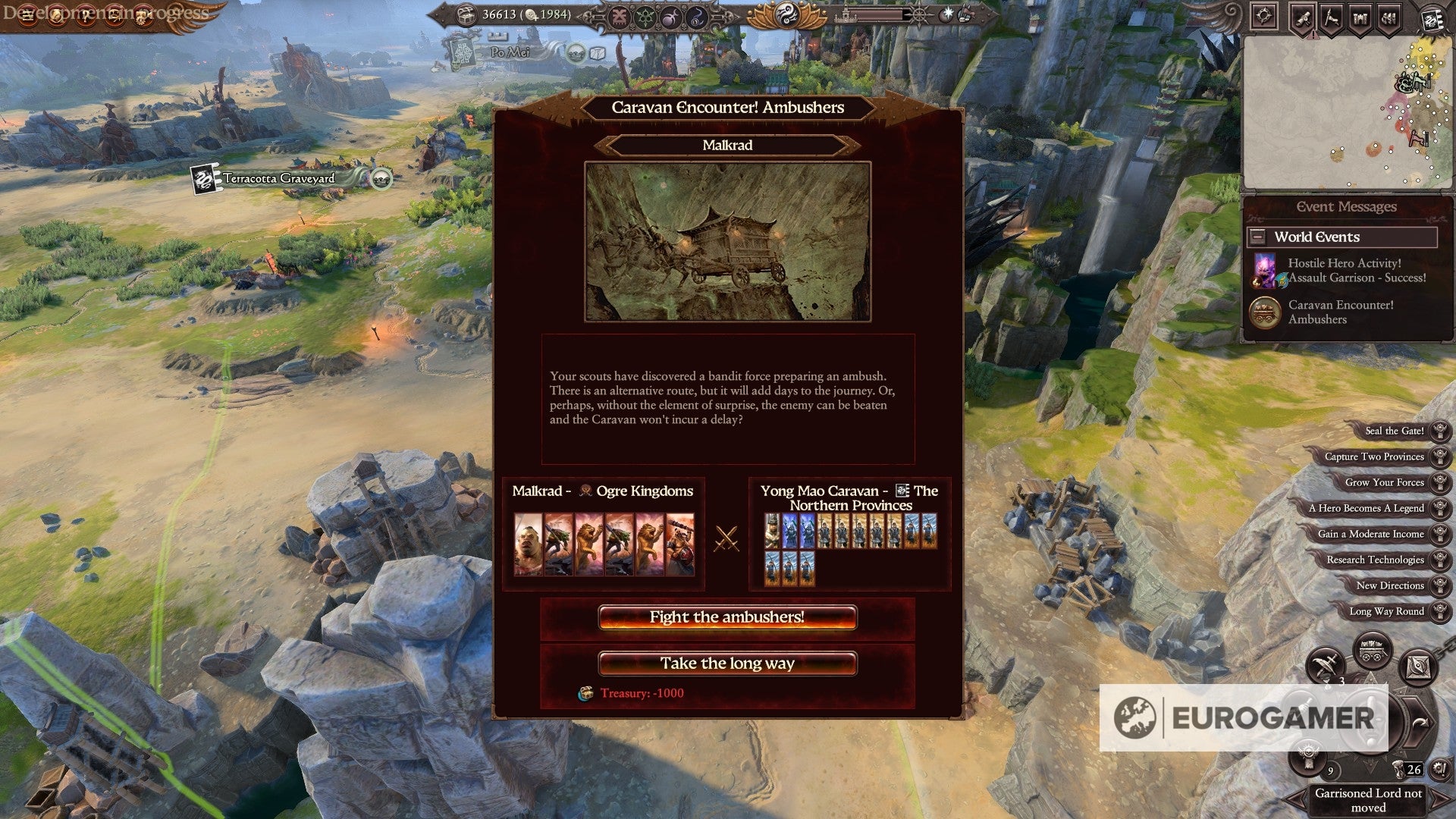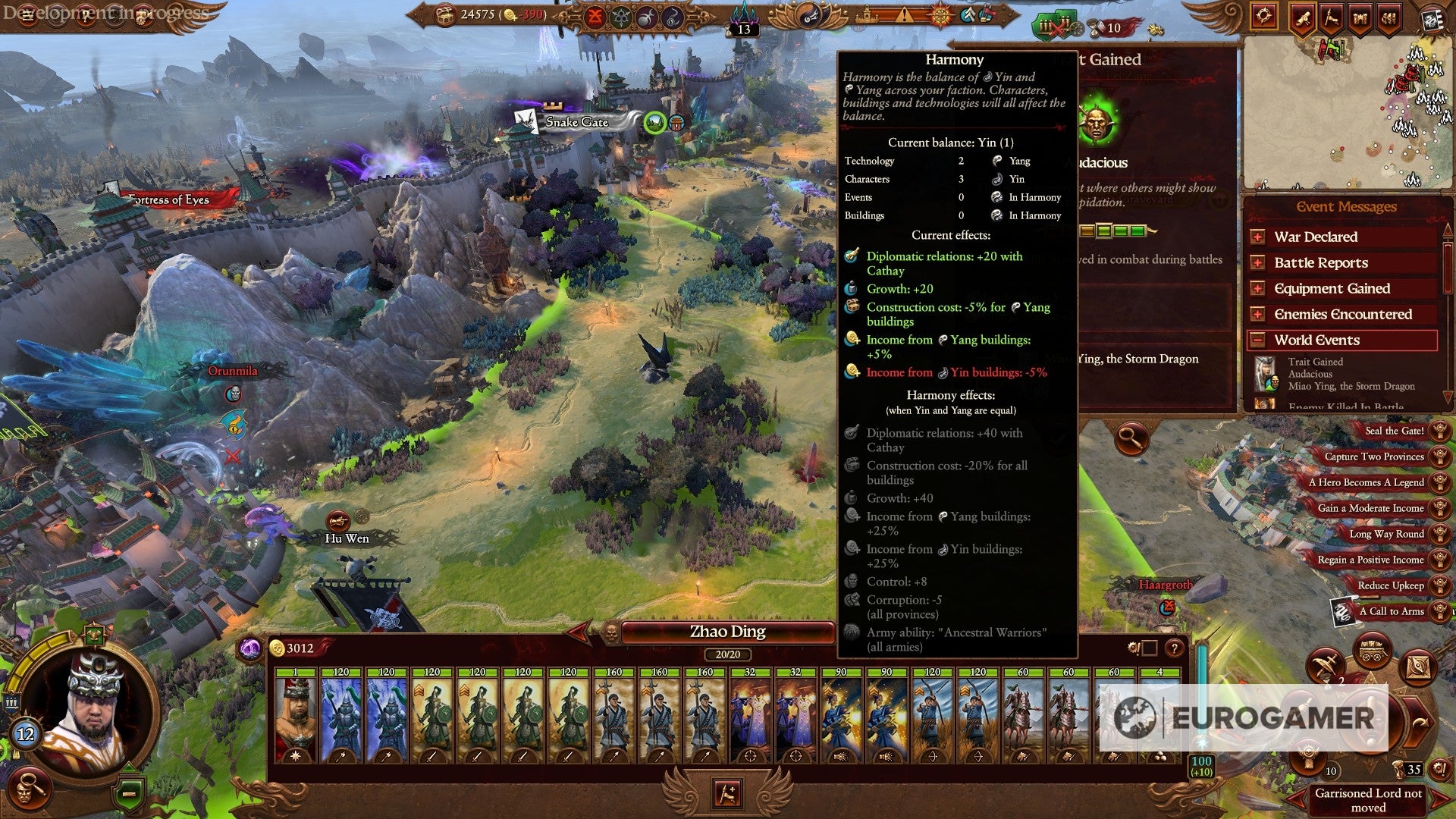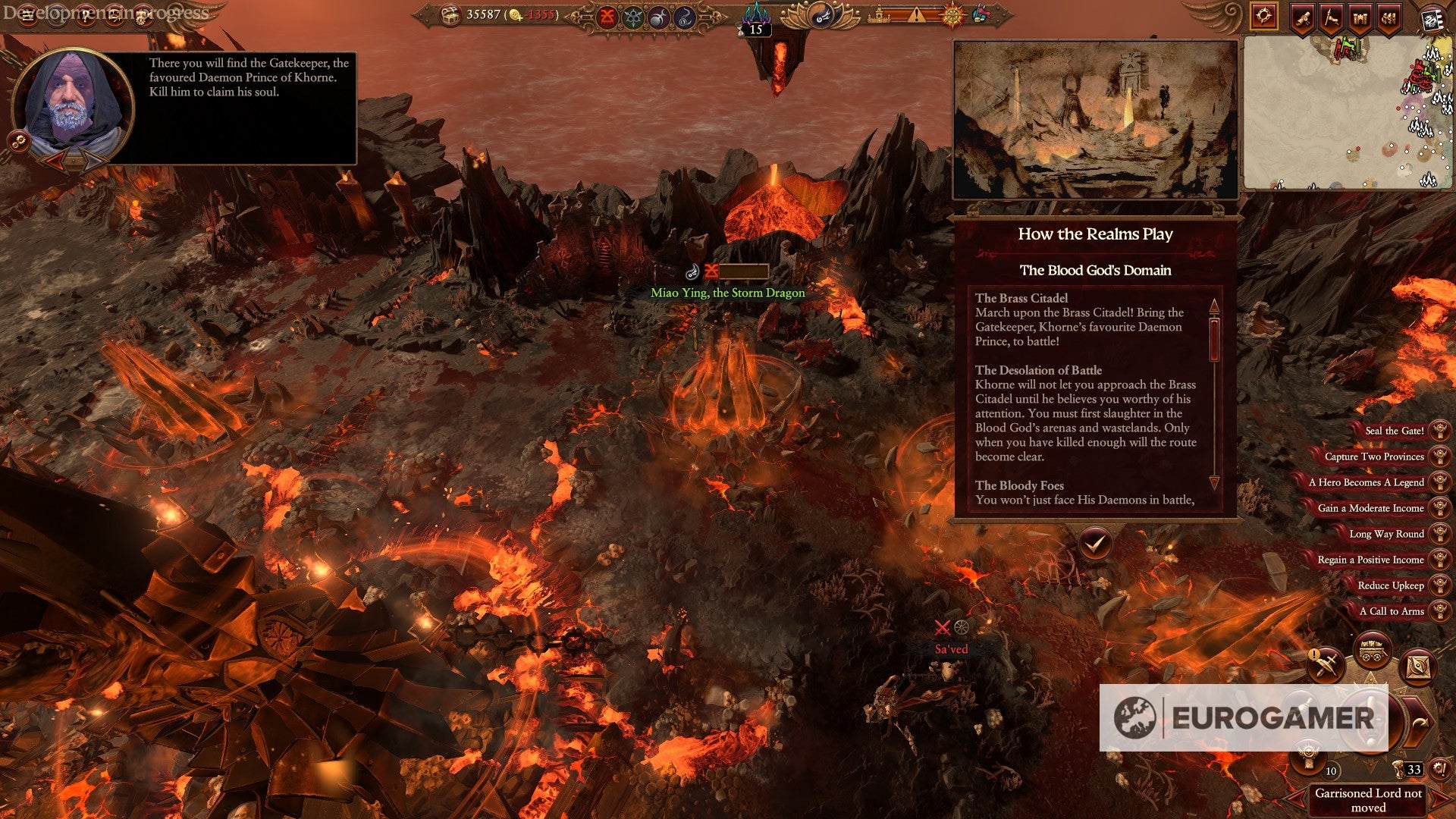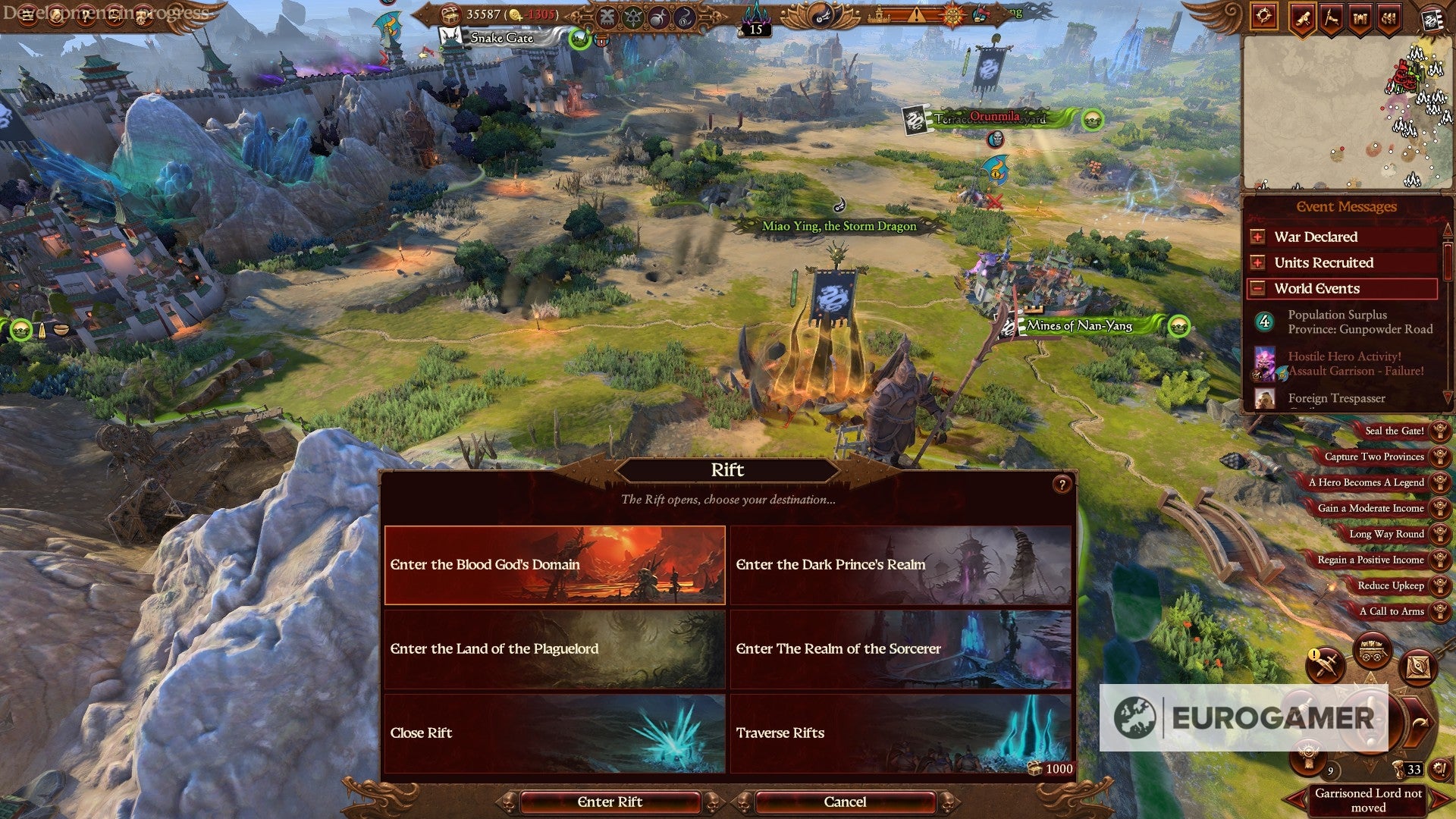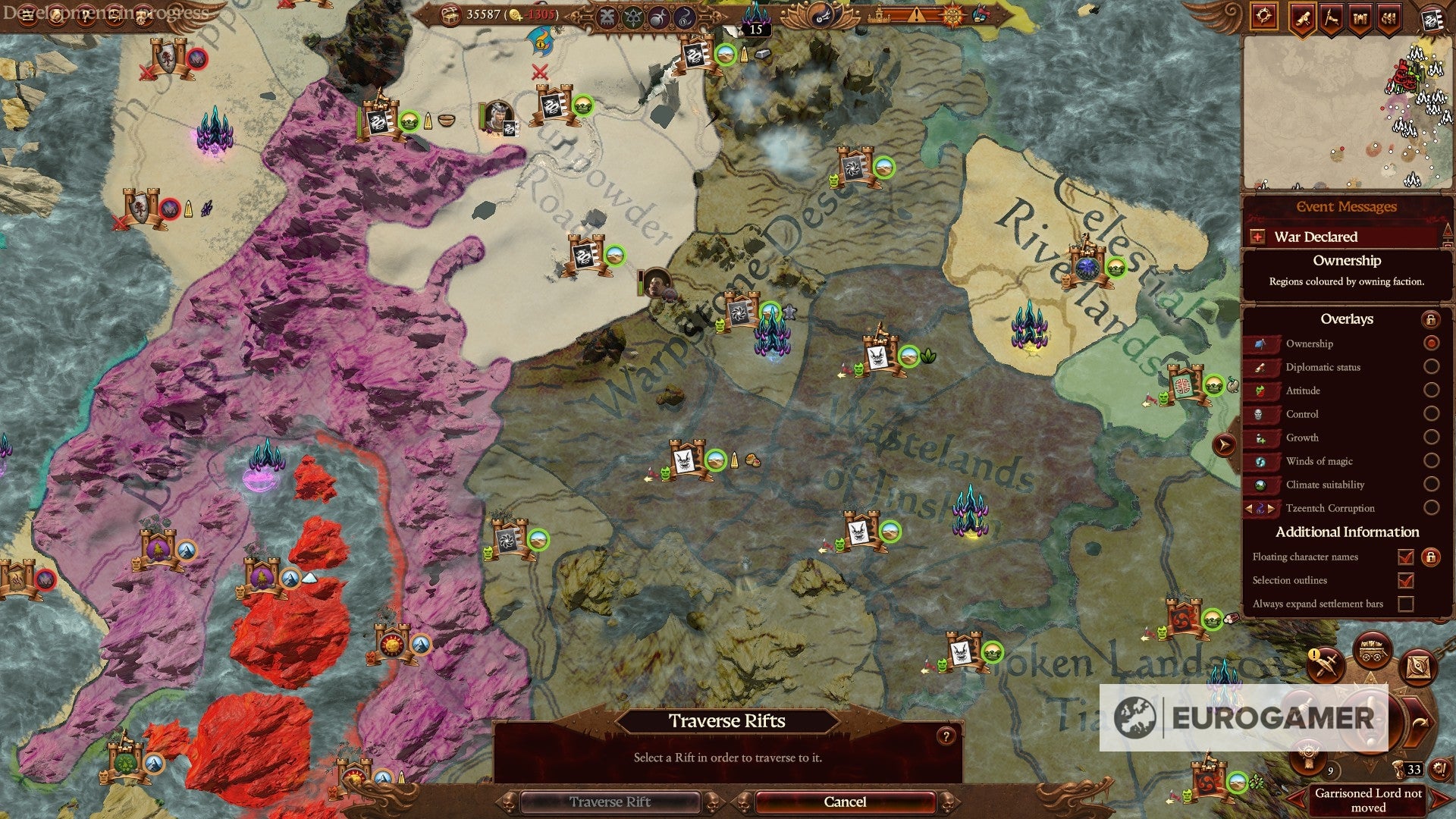Anyway, I am Grand Cathay, where you choose one of two legendary lords as your main character. I have chosen Miao Ying, the Storm Dragon - a woman who can transform, would you believe it, into a Storm Dragon. The other is her brother, Zhao Ming, the Iron Dragon. Your main goal as Grand Cathay, in the story-sandbox playpen of the Grand Campaign, is essentially to turtle. You start out near a giant wall, the other side of which is full of Chaos enemies and corrupted land and all that horrible stuff - only the wall has been breached. There’s also a bar that fills up over time, which you can slow down with certain strategies (a big disc called the Wu Xing Compass that you can point in different directions, largely based around manipulating the winds of magic system, is one, kind of like how you can set a regional decree to focus on growth or money and whatnot). When the bar fills up, the Chaos goons arrive, assaulting the wall in one of three places in vast numbers, and so early on with that wall already breached it’s just about tidying up your land before you secure the gate and get to work on the grander objective (briefly: defeating four Chaos baddies on their own turf, in those horde-like boss battles we tried out a little while back, and then rescuing a god-bear from an ice prison). But I digress. Right now the wall’s breached, Chaos everywhere, go deal with that. This is absolutely up my street. Mopping up enemies, ensnaring them in ambushes and booting them off my land (there is a “get off my land” option in the diplomacy screen now, by the way - more on that later, as this time I literally booted them off by just outright destroying them). With that done it’s off to claim the ruins of the wall and build it up to near impenetrability. My tech-loving, ever-turtling RTS senses are tingling and - oh! Zhao Ming, fancy seeing you here, claiming my section of the wall for your own. Now I have a fully stacked army of my most important ally sitting in the settlement I need to claim, and nothing I can do about it. This is not ideal. It’s also extremely Total War, and exactly the reason I keep coming back to it, the sandboxy weirdness, when it does flare up in funny ways, is where it stands out amongst its peers and where it derives all its character and charm. In Warhammer 3 it seems to be dialled up a little more, if not in any literal sense of design then as a result of the overarching vibe of this game, the sickly-silly Chaos element - they’re five of the eight playable factions - that leaves it full of giant tongues worming out of the ground, the rivers of chunder-green and the beaked, bipedal, neon-pink frog-lords that seem to enjoy waddling about on my land. Back to Cathay though, and let’s talk about what’s new. Cathay is an almost entirely new faction itself, spun into life here from a mere mention in Fantasy Warhammer lore, of that somewhat orientalist cliché of a mysterious land in the east. The orientalism is an ongoing question for me here, the exaggerated nature of fantasy - of very archetypal dwarves, goblins, orks, and so on - not exactly lending itself to subtlety, and the largely deft hand Creative Assembly showed when working with Chinese culture and fiction with Three Kingdoms might be lacking a little. It’s too early to be definitive about this kind of thing - where inspiration and reference stops and caricature begins - but something to keep an eye on approaching launch. As far as running the faction goes, the core twist is that you must balance Yin and Yang, gaining some specific bonuses if you’re leaning more towards one or the other, or a much wider range of bonuses if you’ve perfectly balanced the two. All kinds of things can affect this: buildings constructed in settlements are often labelled as one or the other, while research provides bigger nudges in each direction, +4 Yin for instance, but these take longer to bring into effect, by which point that other Yin building might’ve finished construction and given you one more than you’d accounted for. I’m doing my best to avoid being trite, but: it is a balancing act. The other big one - beyond the wall and enemy wave buildup bar and that big spinny disc - is the Ivory Road, a unique system for trade that Grand Cathay has on top of the usual diplomacy. This has you send caravans and auto-populated guarding armies on missions with your money, where you can visualise the road to different destinations that grant differing levels of money as reward. Depending on the route, there are smaller or greater chances of them being attacked, where pop-up events give you a choice between making some kind of sacrifice (e.g.: letting an Ogre army eat the entirety of one of your units) or battling it out with them on the RTS map. In a way it’s a kind of gamble: how much money do you want to send out with this caravan, on how risky a trip, for how much potential money as a reward. There are various technologies and things you can do to manipulate chances here of course - it wouldn’t be Total War without lots of lovely systems on top of systems - so it feels dynamic, and seems to get tougher, with heftier rewards, as time progresses. This, too, all builds into that sense of turtling powerhouse that makes Grand Cathay such fun to play. Tucking in behind your walls, building up strength, while risking a little to stack up more gold works nicely in symphony - I had a gigantic amount of money after a few hours, on top of several big armies. That said, you will need a lot of armies to get going in Warhammer 3. After a short while, chaos gates will start opening up all over the map. These allow you to travel between them, like sudden shortcuts around the world, or to any of the four Chaos realms, or to close them - which you may well want to do early on, as enemies can use them to travel to you just as you can to them. Likewise, those Chaos realms are very tough in the early game. Going through a gate takes you to a kind of miniature campaign map - these are the places with the worm tongues and the sick rivers and all that - where a load of Chaos armies will roam around. For Khorne, the one I tried out, you need to fill up a kind of rage bar by killing as many enemies as possible before he’ll become available for the boss battle, which played out exactly as my test run did a few months ago - only I fared far worse, with an early-game army that just melted away after a couple of early rounds. Retreating back to the safety of my own realm left me with a somewhat scarred leader on top of her shattered army, with Miao Ying picking up some creepy Chaos traits from having spent time there. All in all, Warhammer 3 is, honestly, a lot. Even watching the demonstration for the Chaos Daemons and their customisable Legendary Lord was a little overwhelming - a gigantic, multi-tiered tech tree of sorts seemed to go on forever - and diving into Grand Cathy involved a lot of “I’ll worry about that later” thinking just to make any progress at all in half a dozen hours. Ian Roxburgh, Warhammer 3’s game director, was keen to address that when I asked him about how new players might find things if they started with this third entry. “First of all,” he said, “a major part of this project has been identifying that very issue - but we haven’t actually announced it in detail yet,” he laughed, “so there will be information coming out in detail before we release the game.” “One of the big things was: we’ve got a bigger and better game here. We’ve got a bigger budget, thanks to the success of the first two games, so what we really wanted to focus on along with all the other innovative game stuff was exactly what you say, the onboarding process - how do we get people through that learning curve of understanding the intricacies of a Total War game and get to that sort of ‘magic gameplay’ as quickly and as easily and smoothly as possible?” “So we’ve done a prologue, which is a standalone mini campaign that is very heavily narrative driven, it’s almost like a storytelling process, with features gradually appearing as you go along, so that players are taken away by the story and gradually learning Total War concepts at the same time.” There are other things I noticed from playing the campaign that should help, too (and honestly, helped me come back from a good year or two away from the series myself), namely the mini-walkthroughs that principle writer Andy Hall called “scripted tours”, optionally taking you through the basics click by click in the campaign and RTS moments. That other big tweak I’d mentioned above is diplomacy. “It’s brought in lots of concepts,” Roxburgh said, explaining that it’s really a collection of new elements from games like Three Kingdoms and Troy, along with “things like the UI, the quick deal concept - where you can see all the factions that may or may not want to do a trade agreement, or an alliance, and all that.” There’s also a way to quickly balance deals, “where you can put something on the table and immediately see what the AI would demand rather than going backwards and forwards and adding 10 gold, 10 gold, to see where that line is.” There’s also region trading, a “threaten button” that helps you throw your military weight around a little more effectively, and the aforementioned Farmer Giles Shotgun option to shout “get off my land” at some pesky raider, which removes all the penalties for going to war with them if they refuse. There’s also a small but potentially brilliant addition in new multiplayer scenarios, designed to play “kind of in an evening with your mates,” as Hall puts it. These are short, few-hours-long micro-campaigns you can play with up to eight players online, with simultaneous turns so you’re not all waiting for that one friend, or trying to keep campaigns alive over months. I’m quite excited to give that a try. Beyond this, though, there is an elephant in the room, which is the giant jigsaw of a map that connects the landmasses of Warhammer 1 and 2 to this new one in Warhammer 3. That’s coming at some point down the line as a free update, with Creative Assembly still quiet on when exactly that is, but it’s arguably the most exciting thing about the lot - and I’m curious about the work that goes into tacking parts of a six-year-old game onto a brand new one. “There is a certain amount of upgrading and updating assets and tech and that kind of stuff,” Roxburgh said, “but predominantly, that new map that all these assets appear on is created from scratch in the latest version so, there’s not as much as you might expect, [in terms of] having to rework old assets, going on. There’s an overhead to it,” he explained, “I guess one of the difficult things is: how do you do all this work - it’s a lot of work - and justify that as a free piece of content? But it was always something that we really wanted to do, it’s a gift back to the fans, because we know when we started looking at how we were going to do Warhammer Fantasy from the beginning - we want to play all this in one go, but we can’t do that in one game, so how are we going to? That was where the idea came from [to] do the three games in detail, and then as a freebie at the end, our fans can get the whole world to play.” “It’s a big undertaking,” he said. “Don’t get me wrong. It’s a lot of work to get that out!” Naturally I am curious about what’s next. “Yeah, give me the difficult one!” Hall laughs. “I mean, this may be the end of the trilogy, but it’s certainly not the end of Total War: Warhammer. There’s no stopping here with Warhammer 3, there’s plans - the format, whether it comes out as DLCs or some kind of GaaS [games as a service] aspect, I suppose, that is up for discussion. I suppose even how you define those terms [is up for discussion too], but the fact of the matter is we will be supporting Total War: Warhammer for years to come. “Take Cathay, for example - this is only the start of Cathay’s journey, really. We’ve been in constant contact with Games Workshop, generating new Cathay material, which will eventually see the light of day. And obviously, there are certain races currently missing from the maps, which I’m sure we’re going to get to in time. So there is plenty more to come.” And - I’m asking this one in full recognition of my own silliness, for the record - is the studio making plans for more Warhammer games beyond Total War? “If we were we probably couldn’t announce it in an interview,” Hall laughs. “We have a really, really good relationship with Games Workshop, that we’ve built up over the last sort of eight to 10 years,” Roxburgh adds, generously, “and that’s why we’re allowed to do things like the Kislev and the Cathay [factions], there’s that mutual trust and respect for what each other does well. “So, you know, that relationship with Games Workshop is not something that’s just going to disappear with Warhammer 3, right? So there’s a lot of things that we’ll be doing post-release for Warhammer 3 and in the future, I’m sure. It’s worked out very well, we’re very happy with the way that’s worked - as are they - and I think, the response to the game so far and hopefully with Warhammer 3 as well is that there’s this growing hunger and desire for more of it. “And it’s been great fun doing it! So, there’s no reason to stop there. Keep your ears open, I’m sure you’ll be hearing stuff in the future - and our fans will be quite happy with what they hear.”
